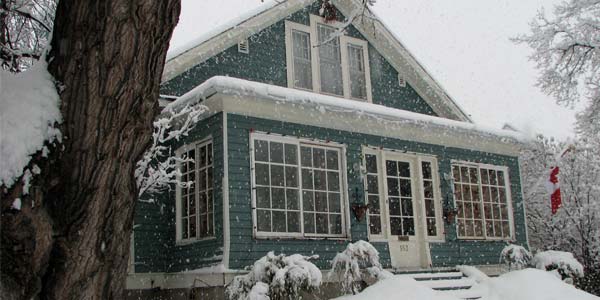
Winter can often be a pain the the side of most homeowners for many reasons; whether it’s the hassle of shoveling, scraping your car down every morning, or the added heating costs. Sure, not everyone is a fan of Winter.
You are certain to find your foundation near the top of that “Not a Fan of Winter” list. Freezing winter weather can have a variety of impacts on your foundation and your home. It is important to be aware of these negative impacts, so you can better safeguard your foundation against permanent long term damage!
Frozen Discharge Line
The first thing you’re going to want to look out for is a frozen discharge line. Your sump pump is the last line of defense between your basement or crawl space and a total flood, so you need to make sure water is able to flow out of your home. It is all too common to see an improperly pitched discharge line freeze, forcing water back into the home. Make sure your discharge lines are pitched on a downward slope, so water is not allowed to rest inside of the line and freeze.
In the event that the discharge line is already frozen, consider cutting it 2 inches from the foundation wall(the ice will generally stop at the foundation wall) and pouring hot water into your sump basin to melt the ice. Once the obstruction is cleared, a rubber boot/coupling may be used to link your discharge link to a new section of unfrozen pipe (use a level to ensure proper pitch on the new line).
Foundation Cracks
Hairline foundation cracks are common year-round, but can be accelerated in the freezing winter months. In the winter, a condition called frost-heave can place enormous amounts of pressure against your foundation walls.
Frost heave occurs when the existing moisture in the soil surrounding your home freezes and expands, adding lots of lateral soil pressure to your foundation. This added pressure can easily provide the force needed to produce cracks on your foundation, large or small. These cracks weaken the structural integrity of your foundation, and can open your home up to seepage, toxic mold, and unwanted pests! Be sure to seal up any foundation cracks with masonry caulk, and consult a foundation repair expert for cracks larger than 1/4″ in diameter.
Moisture and Water Seepage
For some homeowners, foundation issues will begin to arise only after the snow begins to melt. A phenomenon that is commonly overlooked by homeowners, snow melts can introduce huge amounts of water into the soil surrounding your home. This added water in the soil can enter your home in many places; but the most common entrance points are through cracks in the walls or floor, the joint where the floor meets the wall, the top of your foundation wall, and through window and door frames.
Symptoms of a seepage problem can occur before any actual water begins to flow into your home. Remember, actual water flow is an advanced stage of foundation damage, and you’re going to want to look for the basement waterproofing warning signs early. Indicators include dark staining, musty damp odors, peeling paint, rust, and increased bugs and pests.
For exclusive updates and more information, follow our Google+ page here.